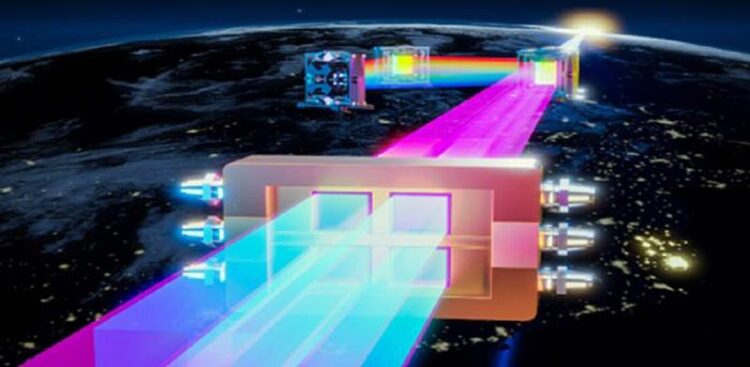Breaking the 10-petawatt limit with a new laser amplification

Coherently tiled titanium:sapphire laser amplification.
Credit: Yuxin Leng
Tiled titanium:sapphire laser amplification promises to enhance the experimental capability of ultra-intense ultrashort lasers for strong-field laser physics.
Ultra-intense ultrashort lasers have a wide-ranging scope of applications, encompassing basic physics, national security, industrial service, and health care. In basic physics, such lasers have become a powerful tool for researching strong-field laser physics, especially for laser-driven radiation sources, laser particle acceleration, vacuum quantum electrodynamics, and so on.
A dramatic increase in peak laser power, from the 1996 1-petawatt “Nova” to the 2017 10-petawatt “Shanghai Super-intense Ultrafast Laser Facility” (SULF) and the 2019 10-petawatt “Extreme Light Infrastructure – Nuclear Physics” (ELI-NP), is due to a shift in gain medium for large-aperture lasers (from “neodymium-doped glass” to “titanium:sapphire crystal”). That shift reduced the pulse duration of high-energy lasers from around 500 femtoseconds (fs) to around 25 fs.
However, the upper limit for titanium:sapphire ultra-intense ultrashort lasers appears to be 10-petawatt. Presently, for 10-petawatt to 100-petawatt development planning, researchers generally abandon the titanium:sapphire chirped pulse amplification technology, and turn to optical parametric chirped pulse amplification technology, based on deuterated potassium dihydrogen phosphate nonlinear crystals. That technology, due to its low pump-to-signal conversion efficiency and poor spatiotemporal-spectral-energy stability, will pose a great challenge for the realization and application of the future 10–100 petawatt lasers. On the other hand, the titanium:sapphire chirped pulse amplification technology, as a mature technology that has successfully realized two 10-petawatt lasers in China and Europe, still has great potential for the next-stage development of ultra-intense ultrashort lasers.
Titanium:sapphire crystal is an energy-level-type broadband laser gain medium. The pump pulse is absorbed to build up a population inversion between the upper and lower energy levels, which completes the energy storage. When the signal pulse passes through the titanium:sapphire crystal several times, the stored energy is extracted for laser signal amplification. However, in transverse parasitic lasing, an amplified spontaneous emission noise along the crystal diameter consumes the stored energy and reduces the signal laser amplification.
Currently, the maximum aperture of titanium:sapphire crystals can only support 10-petawatt lasers. Even with larger titanium:sapphire crystals, laser amplification is still not possible because strong transverse parasitic lasing increases exponentially as the size of the titanium:sapphire crystals increases.
In response to this challenge, researchers have taken an innovative approach that involves coherently tiling multiple titanium:sapphire crystals together. As reported in Advanced Photonics Nexus, this method breaks through the current 10-petawatt limit on the titanium:sapphire ultra-intense ultrashort lasers, effectively increasing the aperture diameter of the entire tiled titanium:sapphire crystal and also truncating the transverse parasitic lasing within each tiling crystal.
Corresponding author Yuxin Leng of the Shanghai Institute of Optics and Fine Mechanics notes, “The tiled titanium:sapphire laser amplification was successfully demonstrated in our 100-terawatt (i.e., 0.1-petawatt) laser system. We achieved near-ideal laser amplification using this technology, including high conversion efficiencies, stable energies, broadband spectra, short pulses, and small focal spots.”
Leng’s team reports that coherently tiled titanium:sapphire laser amplification provides a relatively easy and inexpensive way to surpass the current 10-petawatt limit. “By adding a 2×2 coherently tiled titanium:sapphire high-energy laser amplifier in China’s SULF or EU’s ELI-NP, the current 10-petawatt can be further increased to 40-petawatt and the focused peak intensity can be increased by nearly 10 times or more,” says Leng.
The method promises to enhance the experimental capability of ultra-intense ultrashort lasers for strong-field laser physics.
For details, see the original Gold Open Access article by Y. Liu, K. Liu, et al., “Coherently tiled Ti:sapphire laser amplification: a way to break the 10 petawatt limit on current ultraintense lasers,” Adv. Photon. Nexus 2(6) 066009 (2023), doi 10.1117/1.APN.2.6.066009.
Journal: Advanced Photonics Nexus
DOI: 10.1117/1.APN.2.6.066009
Article Title: Coherently tiled Ti:sapphire laser amplification: a way to break the 10 petawatt limit on current ultraintense lasers
Article Publication Date: 23-Dec-2023
Media Contact
Daneet Steffens
SPIE–International Society for Optics and Photonics
daneets@spie.org
Office: 360-685-5478
All latest news from the category: Physics and Astronomy
This area deals with the fundamental laws and building blocks of nature and how they interact, the properties and the behavior of matter, and research into space and time and their structures.
innovations-report provides in-depth reports and articles on subjects such as astrophysics, laser technologies, nuclear, quantum, particle and solid-state physics, nanotechnologies, planetary research and findings (Mars, Venus) and developments related to the Hubble Telescope.
Newest articles

Innovative 3D printed scaffolds offer new hope for bone healing
Researchers at the Institute for Bioengineering of Catalonia have developed novel 3D printed PLA-CaP scaffolds that promote blood vessel formation, ensuring better healing and regeneration of bone tissue. Bone is…

The surprising role of gut infection in Alzheimer’s disease
ASU- and Banner Alzheimer’s Institute-led study implicates link between a common virus and the disease, which travels from the gut to the brain and may be a target for antiviral…

Molecular gardening: New enzymes discovered for protein modification pruning
How deubiquitinases USP53 and USP54 cleave long polyubiquitin chains and how the former is linked to liver disease in children. Deubiquitinases (DUBs) are enzymes used by cells to trim protein…


